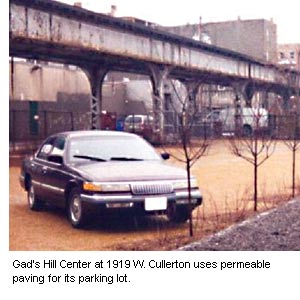Permeable Paving
 |
Permeable paving refers to paving materials – typically concrete, stone or plastic – that promote absorption of rain and snowmelt. The discussion that follows focuses primarily on one form of permeable pavement – paving blocks and grids, as they are the most common and available type of permeable paving. These modular systems contain openings that are filled with sand and/or soil. Some can support grass or other suitable vegetation, providing a green appearance. A portion of rainfall is trapped in the block's depressions and infiltrates into the underlying soil. Permeable paving is effective in reducing the quantity of surface runoff, particularly for small to moderate-sized storms. It also reduces the runoff pollutants associated with these events. Permeable paving in Chicago will be most effective in areas closer to Lake Michigan that are underlain with sandy, permeable soils. Effectiveness can be improved by designs that:
|
Permeable paving may have aesthetic and marketing advantages over conventional paving, depending on the materials selected. Vegetated pavers, in particular, could substantially improve the aesthetic appeal of paved areas. Vegetated pavers also can be effective in reducing the “urban heat island” effect
|
An alternative form of permeable paving is porous pavement that relies on larger particles in the aggregate to rapidly infiltrate precipitation into an underlying stone "reservoir." While not discussed at length in this guide, porous pavement may be a suitable option for certain low-impact applications. Porous pavement may be prone to clogging, be adversely affected by the freeze/thaw cycle and can have higher maintenance requirements than permeable paving. However, some recent reports - mostly from warmer climates - conclude that porous pavement may be a reliable, cost-effective alternative. One key consideration when using porous pavement is to ensure that the aggregate is sufficiently durable. Applicability Maintenance Considerations |
 |
 |
Cost Considerations Local Example
|
